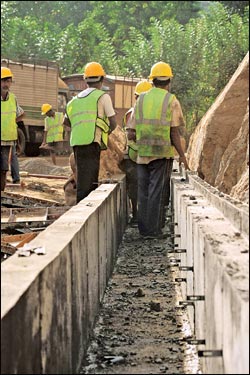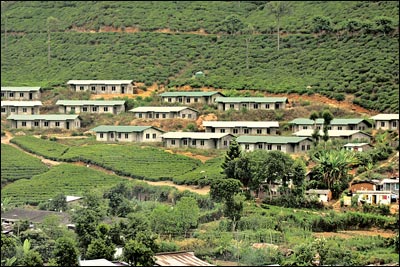 All-around
development in Moneragala All-around
development in Moneragala
Moneragala is the second largest district in the island surrounded by
Ampara district from the North and East, Hambantota district from the
South, Badulla district from West and North,and Ratnapura district from
the South East.
The district which has inherited a civilization of one hundred
thousand paddy fields is also renowned as “Wellassa”. It is in this
district at the place called Maligawila that one can find the world
famous Avalokitheswara Buddha Statue which had been entirely sculptured
from a rock and stands without any external support.
These consisth Buduruwagala, Yudanganawa shrine, Dematamal temple,
Kirivehera, Maligawila Buddha Statue, ancient Temple of Galmatimandiya
as the main places of worship. The Kataragama Holy Site, which is sacred
to Buddhists, Hindus, Muslims and Christians, has made the district
well-known all over the world.
|

Boost for agriculture |
Although the district is situated in a wet intermediate climatic
zone, 70 percent of the areas in the district possess a dry zone
environment. The annual rainfall amounts to 1625 mm and the annual
medium temperature amounts to 26 degree centigrade.
The total population of the district amounts to 420,000 persons and
majority of them live in villages. The village population amounts to 98
percent.
Estate population amounts to 2 percent and there is no signification
percent of urban population as such. 94 percent of the population is
Sinhalese. The population density amounts to 1:72 sq. km.
There are 11 District Development Secretarial Divisions in the
District, namely Moneragala, Badalkumbura, Siyambalanduwa, Bibile,
Medagama, Madulla, Buttala, Wellawaya, Thanamalvila, Sevanagala and
Kataragama.
The population in the Wellawaya District Development Secretariat
Division amounts to 53,659 persons, and which is the highest populated
area in the district.
Over 40 percent of the people in this Secretariat Division are
recipients of Samurdhi assistance. In the Sevanagala Secretariat
Division 23.91 percent of the population receive Samurdhi assistance.
There are 319 Grama Niladhari Divisions within the district covering
1324 villages.
In order to streamline administrative activities there are 17 Farmers
Centres, 10 Pradeshiya Sabhas and 12 Police Stations within the
district.
Majority of areas in the district come under forest cover.
Accordingly there are 116,588.31 hectares of thick forests, 89,422.8
hectares of open forests, and 6,517.33 hectares of cultivated forests in
the districts.
The area under irrigation amounts to 14,816.60 hectares. There is
another extent of 5,260.70 hectares cultivated with rain water. There
are 872.52 hectares of tea land, 12,579.93 hectares under coconut
cultivation and 6.31 hectares cultivated with cinnamon.
|

Basic infrastructure in place |
The first development village established under Mahinda Chintana
Village Development Scheme was the Jayamini Gama. This village which was
a very remote and extremely backward village in the past has become
today as a village provided with maximum facilities.
Village Development
Sri Lanka Samurdhi Authority and Nation Building Ministry as the
Planning Ministry provided funds for development of Jayamini Gama.
The allocation of funds covered Rs 3238,557 for educational
development, Rs 1,095,271 for electricity supplies, Rs 852,710 for Road
Development and Rs 8,043,455 for water supply schemes.
Further, Rs 2,857,500 was provided for housing development activities
with the objective of alleviating the housing problem, Rs 723,142 for
development of marketing facilities of produce accrued from the village,
Rs 7,923,830 for development of irrigation facilities, Rs 256,080 for
construction healthy latrines, Rs 908,650 for development of
pre-schools, Rs 175,000 for construction of e-centres with the objective
of introducing information technology to the village, Rs 375,000 for
agricultural development, Rs 200,000 for construction of Cooperative
buildings, Rs 1,850,000 for construction of the Divisional Secretariat
building, Rs 750,000 for construction of a seed marketing centre, and Rs
543,700 for development of employment avenues were expended for
development of this village, the Jayamini Gama.
The Gama Neguma Project has assumed a special place naturally because
98 percent of the population in the district lives in villages. The
initial village development project has become one of the model village
development projects with the development of several other villages
throughout the district. One such project was the development of the
Thenagallanda village.
This village with the provision of all necessary facilities has
become upgraded to the status of sub-township. The Government spent Rs
4,365,385.95 for the development roads, Rs 3,380,000 for supply of
electricity, Rs 460,000 for development of employment avenues, Rs
378,180 for agricultural development, Rs 1,400,000 for the construction
of Village Secretariat Office, Rs 25,000 for development of Daham Pasals
in this village.
|

New road construction in process |
Rohanapura, Indunilpura in the Thanamalvila Divisional Secretariat
Division is another village that was given life under the Gama Neguma
project.
Before the launch of the Gama Neguma Scheme, this village situated in
the southern corner of the Thanamalvilla division was a very remote and
backward village.
The Government has spent Rs 2,431,223.74 for road development in this
village, Rs 14,502,247 for electricity development, and Rs 400,000 for
construction of Nena Sela of this village. A further sum of Rs 100,000
was provided under the second stage to complete shortcomings in road
development.
Another village so developed was the Polgahagama village in the
Madulla Divisional Secretariat Division. There are 184 families living
in this village.
The Government spent Rs 200,000 for road developments in the village,
Rs 9,846,540 was spent for qualitative improvement of electricity
supplies, Rs 1,471,443.14 was expended for the construction of the
multi-functional building, Rs 1,043,105.17 for the construction of the
village Secretariat office, and Rs 94,000 for agricultural development.
Another beautiful village so developed was the Hittawelkivula in the
Medagama Divisional Secretariat Division. The Government spent Rs
826,447 for road developments in this village, Rs 50,000 for water
supply, Rs 448,500 for Irrigation development, and Rs 1,000,000 for
construction of Jana Sabha Secretariat Office. For the second stage road
improvement activities a further sum of Rs 1,983,886 was spent.
In the Bulapitiya village of the Bibile Divisional Secretariat
Division Rs 588,000 was spent for road construction work, and Rs
1,090,736 was spent for the construction of the Jana Saba Secretariat
office. These sums were spent for the benefit of 145 families living in
this village.
Development of Schools
Moneragala district is a combination of three educational zones. The
educational divisions of Bibile, Madulla and Medagama come under the
Bibile educational zone.
There are 23 schools in the Bibile education division, 22 schools in
the Madulla educational division and 28 schools in the Medagama
educational division. Moneragala, Siyambalanduwa and Badalkumbura
educational divisions come under the Moneragala educational zone. There
are 31 schools in the Moneragala educational division, 33 schools in the
Siyambalanduwa educational division and 38 schools in the Badalkumbura
educational division.
|

Housing facilities shaping up |
Wellawaya, Buttala, Thanamalvila, Sevanagala and Kataragama
educational divisions come under the Wellawaya educational zone.
Respectively there are 29,33,16, 15 and 4 schools in these educational
divisions. Majority of students in the district receive their education
in Siyambalanduwa, Buttala and Wellawaya educational divisions and the
total student population in the district amounts to 97,684.
The teaching staff in the district amounts to 5,085. On an average
the district has a teacher/student ratio of one teacher for each 20
student.
It was possible to reduce the teach/student ratio to this level
because when 40,000 Graduate Teachers were recruited most of them were
assigned to districts which were considered as remote and backward
schools in the country.
In the provision of information technological facilities to
fully-fledged schools, the Government paid a special attention to the
Moneragala district.
Development of Health Facilities
Health facilities in the district cover one General/District
Hospital, 9 Rural Hospitals, 1 Central Dispensary, 7 Ayurvedic Clinics,
and 5 Maternity Homes.
The Government has been able to raise the health and nutrient
standards of the people in the district because it has provided 32
Public Health Inspectors, 161 Family Health Service Officers to serve in
the 11 District Divisional Secretariat Divisions in the District.
Courtesy:
Development.lk |



